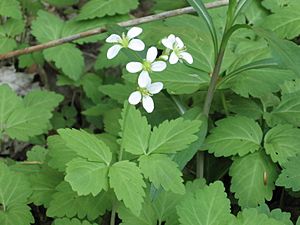Broadleaf toothwort facts for kids
Quick facts for kids Broadleaf toothwort |
|
|---|---|
 |
|
| Scientific classification | |
| Genus: |
Cardamine
|
| Species: |
diphylla
|
| Synonyms | |
|
Dentaria diphylla Michx. |
|
Cardamine diphylla is a cool plant from North America. It has many common names like broadleaf toothwort or crinkle root. This plant grows in woodlands during springtime. You can find it in many parts of eastern North America.
Contents
Where Does Toothwort Grow?
This plant grows in many places across eastern North America. You can find it from Georgia all the way north to Ontario, Canada. It also grows from the Atlantic coast to Wisconsin.
It likes moist woodlands, especially at the edges of forests. The plant blooms with pretty flowers from April to June. It is part of the mustard family.
What Does It Look Like?
Cardamine diphylla has flowers with four petals. These flowers grow in a cluster on one tall stem. Below the flowers, there is a pair of leaves. Each leaf has three broad parts with jagged edges.
After the flowers fade, long, thin seedpods appear. These pods grow just below where the flowers were. The plant usually grows to be about 30 centimeters (12 inches) tall.
A Home for Butterflies
The West Virginia white butterfly loves this plant. This butterfly lays its eggs on Cardamine diphylla. When the eggs hatch, the young caterpillars eat the plant's leaves.
However, there's a problem for these butterflies. A plant called garlic mustard looks very similar to Cardamine diphylla. The butterflies sometimes lay their eggs on garlic mustard by mistake. Sadly, their caterpillars cannot survive on garlic mustard.
Garlic mustard also takes up space and nutrients that Cardamine diphylla needs to grow. This makes it harder for the toothwort to survive. Removing garlic mustard helps protect the West Virginia white butterfly.
How Native Americans Used Toothwort
Native American tribes have used Cardamine diphylla for a long time. They used it for both medicine and food.
Toothwort as Medicine
Many tribes used the root of the toothwort plant for different health issues.
- The Algonquin people of Quebec would grind the root. They mixed it with vinegar to make a relish. They also gave a special tea made from the plant to children with fevers.
- The Algonquin also mixed toothwort with sweet flag root. They used this mix to help with heart problems.
- The Cherokee tribe used the root in several ways. They put a crushed root on headaches. They chewed the root to help with colds. They also gargled with a tea made from the plant for sore throats.
- The Lenape and Delaware Nation of Oklahoma used the roots to help with stomach problems.
- The Iroquois tribe chewed the raw root for stomach gas. They also put crushed roots on swollen areas of the body. For fevers, they drank a cold tea made from the plant.
Toothwort as Food
Toothwort was also an important food source for some tribes.
- The Abenaki tribe used it as a seasoning, like a spice.
- The Cherokee would boil the stems and leaves. They would then rinse them and add hot grease, salt, and water. They boiled them until soft, like cooked greens. They also ate the fresh leaves in salads.
- The Iroquois tribe ate the roots raw with salt or boiled them.
- The Ojibwe tribe mixed the roots with salt, vinegar, or sugar. They used this mix as a condiment, similar to a relish or sauce.
See also
 In Spanish: Cardamine diphylla para niños
In Spanish: Cardamine diphylla para niños

